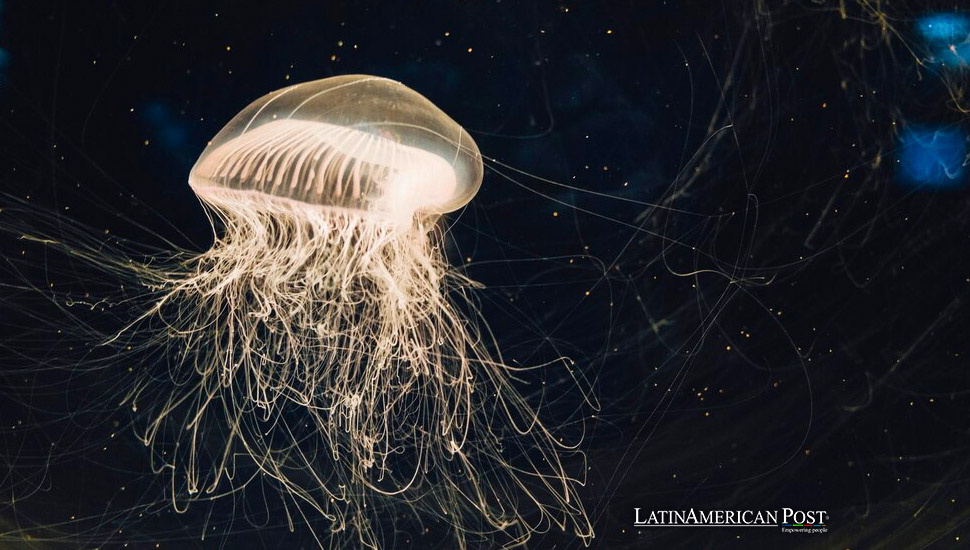Jellyfish as Food: Exploring the Potential in Latin America

Jellyfish, a staple in Asian diets, is unexplored mainly as a food source in Latin America. A recent study delves into the region’s acceptance of jellyfish consumption, revealing significant cultural and demographic insights that could shape future food markets.
As the world faces increasing pressure to find sustainable food sources, unconventional options like jellyfish are gaining attention. While jellyfish consumption is a longstanding tradition in many Asian countries, it remains largely unexplored in other parts of the world, including Latin America. However, with global food needs rising and marine biodiversity in Latin America offering an abundant supply of jellyfish, there is growing interest in the potential for jellyfish to become a viable food source in the region.
A recent study published in the Food Quality and Preference journal investigated the attitudes of Latin American populations toward jellyfish as food. It was conducted through an online survey with 6,597 participants from nine countries—Argentina, Brazil, Chile, Colombia, Ecuador, El Salvador, Mexico, Peru, and Uruguay—the research aimed to understand the factors influencing the acceptance of jellyfish consumption across the region. The study’s findings reveal significant socio-demographic trends, cultural differences, and challenges that could impact the future of jellyfish as a sustainable food source in Latin America.
A Staple in Asia, an Untapped Resource in Latin America
Jellyfish have long been a delicacy in Asian cuisine, particularly in China, Japan, and Korea. They are valued for their unique texture and nutritional benefits. In contrast, Western countries, including Latin America, have historically viewed jellyfish as a nuisance rather than a potential food source. However, as global interest in sustainable and alternative protein sources grows, the culinary potential of jellyfish is being reconsidered.
The study highlighted that jellyfish are abundant in the coastal waters of Latin America, a region known for its rich marine biodiversity. Countries like Mexico, Peru, and Argentina have documented jellyfish fisheries, although the practice is not widespread. Given the increasing demand for sustainable food options and the availability of jellyfish in Latin American waters, there is a significant opportunity to explore jellyfish as a food source in the region.
The online survey conducted in nine Latin American countries provided valuable insights into how different populations perceive jellyfish as food. The participants ranged in age from 18 to 90, with a balanced gender distribution (55.9% female and 43.2% male). The survey asked questions about socio-demographics, personality traits, and attitudes toward jellyfish consumption, aiming to uncover the factors influencing the acceptance of this unconventional food source.
Demographics and Jellyfish Consumption
The study found that acceptance of jellyfish as food (referred to as Jellyfish Consumption Acceptance or JCA) varied significantly across different demographic groups. One of the most striking findings was the positive correlation between JCA and factors such as age, educational level, and income. Older individuals, those with higher levels of education, and those with higher incomes were generally more open to consuming jellyfish. This suggests that awareness and understanding of the potential benefits of jellyfish consumption are higher among these groups.
Conversely, the study found that food neophobia (the fear of trying new foods) and disgust sensitivity were negatively correlated with JCA. Participants with higher levels of food neophobia or a solid aversion to unfamiliar foods were less likely to accept jellyfish as a potential food source. These findings align with research on Western societies’ barriers to adopting novel foods, such as insects and cultured meat.
The survey also revealed significant cultural differences in attitudes toward jellyfish consumption across the nine countries. The highest levels of JCA were observed in Argentina and Peru, where participants showed a greater willingness to incorporate jellyfish into their diets. In contrast, Ecuador and El Salvador recorded the lowest acceptance levels, with participants expressing more reluctance to try jellyfish.
Interestingly, the study identified four distinct groups of countries based on their acceptance of jellyfish consumption:
Group 1: Peru, Argentina, Mexico, Colombia, and Brazil—Countries with relatively high acceptance levels and a willingness to experiment with jellyfish in various culinary forms.
Group 2: El Salvador—A country with moderate acceptance, where jellyfish consumption is less common but not entirely rejected.
Group 3: Chile and Uruguay—Countries with lower acceptance levels, where jellyfish are viewed skeptically and less likely to be embraced as a food source.
Group 4: Ecuador—A country with the lowest acceptance, where cultural and possibly environmental factors may contribute to the resistance to jellyfish consumption.
These groupings highlight the need for tailored approaches to introducing jellyfish as a food source in different parts of Latin America. Strategies that work in one country may not be effective in another, emphasizing the importance of understanding local cultural contexts when promoting new food products.
How Latin Americans Want Their Jellyfish
Beyond general acceptance, the survey explored how participants would prefer to consume jellyfish. The responses revealed various culinary preferences, with significant variations depending on the region. For example, participants from northern hemisphere countries (El Salvador, Mexico, and Colombia) preferred jellyfish as a visible ingredient in dishes, often paired with traditional flavors and spices.
In contrast, participants from middle-latitude countries (Ecuador, Peru, and Brazil) were more open to jellyfish as a hidden ingredient or in fusion dishes that blend local and international cuisines. Southernmost countries (Uruguay, Argentina, and Chile) preferred more subtle uses of jellyfish, such as in soups or stews where the texture of the jellyfish could be masked or complemented by other ingredients.
These culinary preferences reflect Latin America’s diverse food cultures and suggest successfully introducing jellyfish as a food source will require adapting recipes and cooking methods to suit local tastes.
One key argument for promoting jellyfish as a food source is its nutritional profile. Jellyfish are low in calories and cholesterol while high in proteins, mainly collagen and polyunsaturated fatty acids. These dietary benefits could make jellyfish an attractive alternative protein source, especially in regions with expensive or scarce traditional protein sources.
The study noted that more health-conscious participants with specific dietary needs were more likely to accept jellyfish as a food source. This suggests that highlighting the health benefits of jellyfish, such as its low-fat content and high protein levels, could be an effective strategy for increasing its acceptance among Latin American consumers.
Challenges to Acceptance
Despite the potential benefits, the study identified significant barriers to accepting jellyfish as food, particularly food neophobia. This psychological trait, which involves a fear of trying unfamiliar foods, was the most critical factor influencing participants’ reluctance to consume jellyfish.
In Latin America, where traditional diets are deeply ingrained and food customs are closely tied to cultural identity, overcoming food neophobia presents a significant challenge. The study suggests that education and exposure to jellyfish as a food source could help reduce this barrier. By introducing jellyfish in familiar forms or through dishes that blend traditional and novel ingredients, it may be possible to increase acceptance gradually.
The introduction of jellyfish as a food source in Latin America also has significant economic and environmental implications. From a financial perspective, developing a jellyfish fishery could provide new opportunities for coastal communities, particularly in countries with abundant jellyfish populations. By diversifying their fishing activities, these communities could benefit from a new and potentially lucrative market.
Environmentally, jellyfish are a sustainable choice compared to traditional fish stocks, many of which are overfished or depleted. Jellyfish are abundant and reproduce quickly, making them a renewable resource that could help meet the growing demand for protein without placing additional strain on marine ecosystems.
However, the study also cautions that the establishment of jellyfish fisheries must be carefully managed to avoid unintended consequences. Overharvesting jellyfish could disrupt local ecosystems, and clear regulations and guidelines are needed to ensure that jellyfish are harvested sustainably. Additionally, the study highlights the importance of food safety regulations, currently lacking in many Latin American countries, to ensure that jellyfish products meet health and safety standards.
A Promising Future for Jellyfish in Latin America
The study provides a comprehensive overview of the potential for jellyfish to become a sustainable food source in Latin America. While significant challenges remain, including food neophobia and cultural differences, the findings suggest that there is also substantial potential for growth in this market.
By understanding the factors that influence acceptance and tailoring approaches to different cultural contexts, jellyfish may be introduced as a viable and popular food source in Latin America. With its nutritional benefits and environmental sustainability, jellyfish could play a key role in the region’s future food security.
As Latin American countries continue to explore new ways to meet the growing demand for food, jellyfish offer a unique opportunity to diversify diets, support local economies, and promote sustainable fishing practices. The road ahead will require careful planning, education, and collaboration between governments, communities, and the private sector. However, with the right strategies, jellyfish could soon become standard on dinner plates across Latin America.
Also read: Guayusa Ritual as an Energizing Tradition in Ecuador’s Amazon
The study illuminates the untapped potential of jellyfish as a food source in Latin America, offering valuable insights for policymakers, businesses, and consumers. As the region faces the challenges of a growing population and changing climate, embracing new and sustainable food sources like jellyfish could be a key step toward ensuring a secure and resilient future.





